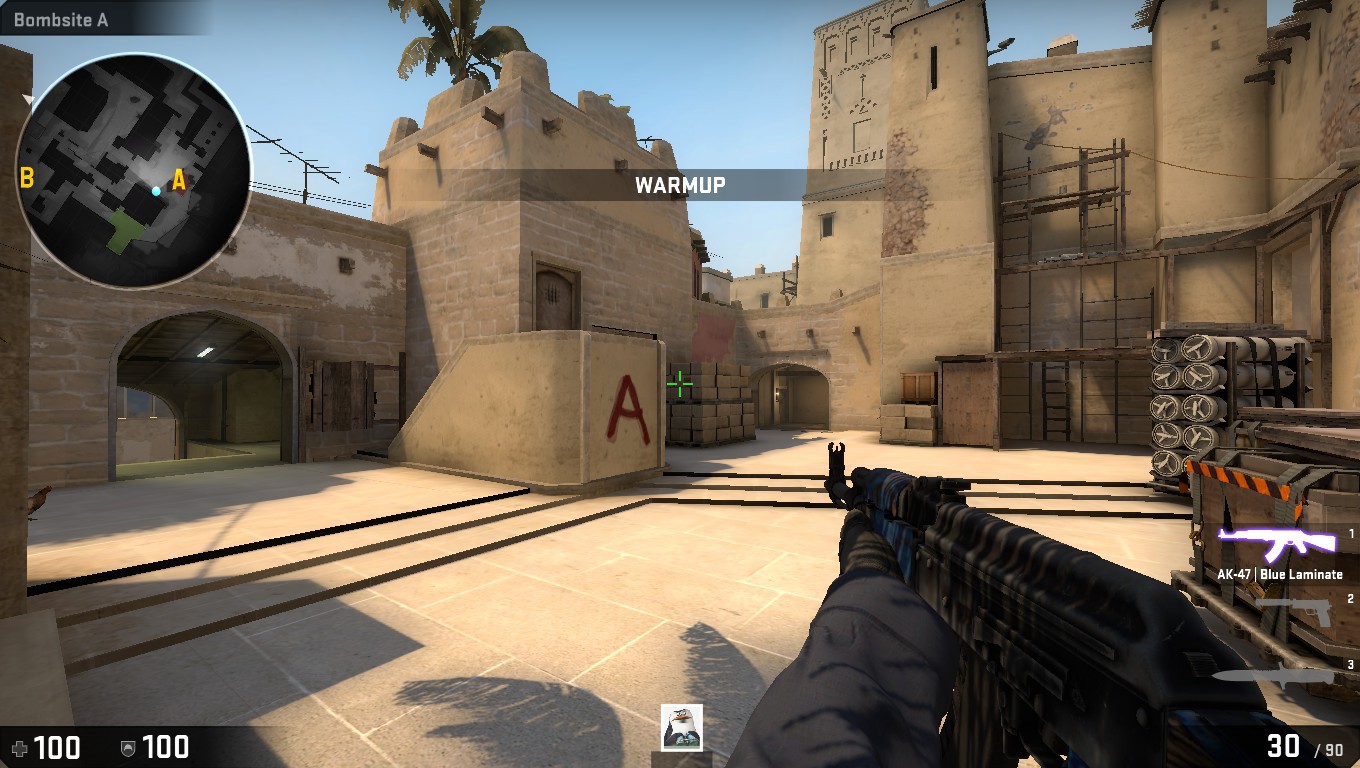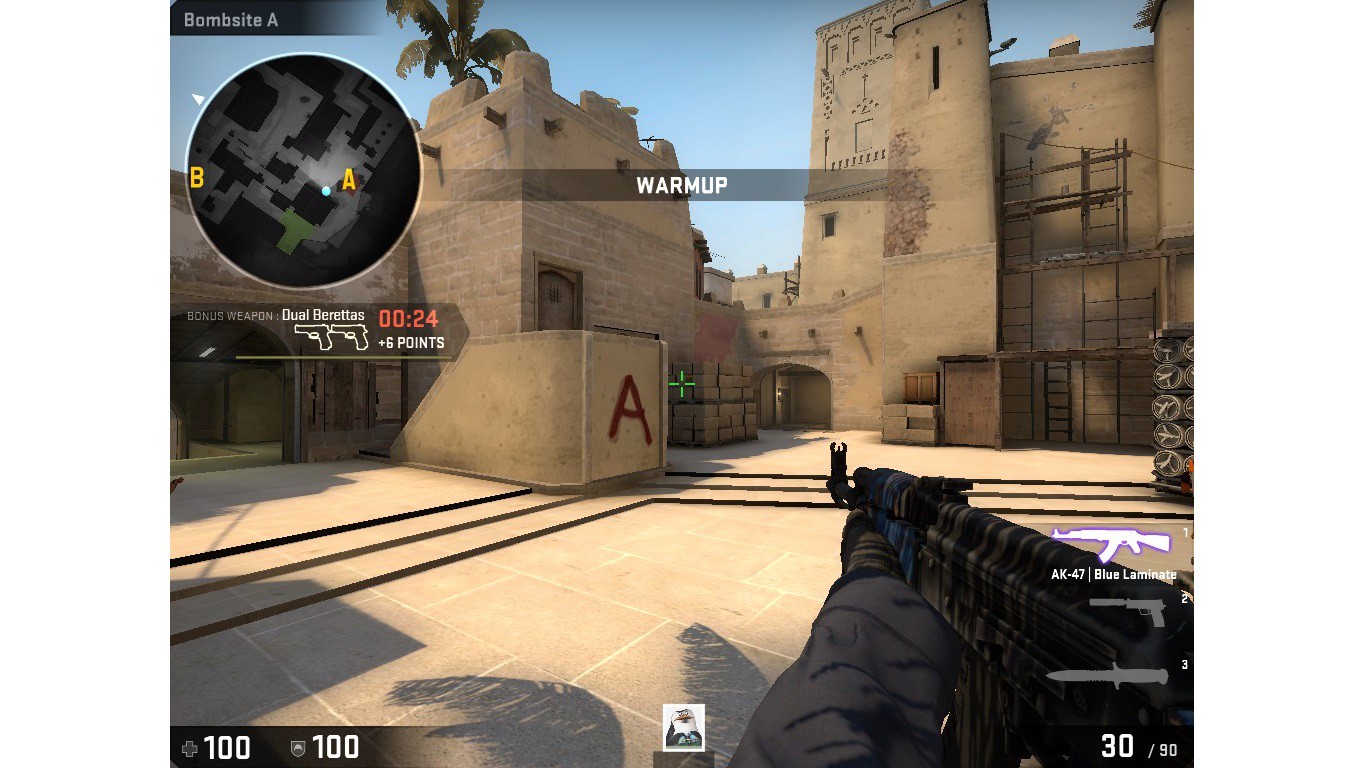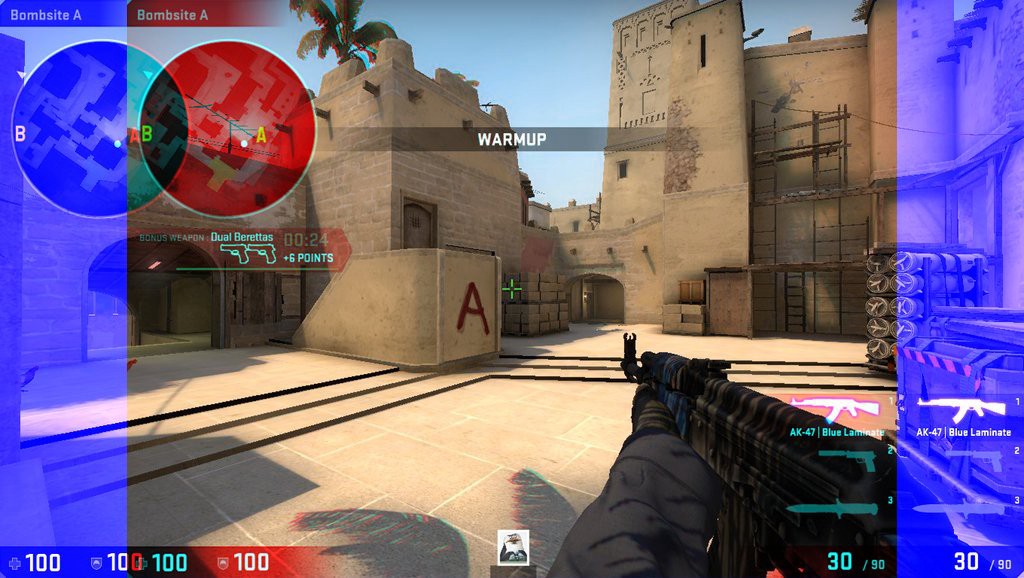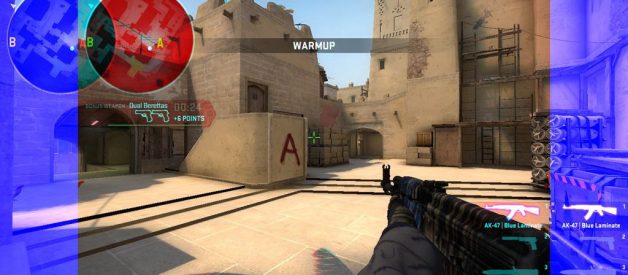While making the case for 16:9 will not lead to many people changing their in-game settings for CS:GO, putting all the arguments in one place should allow them to be easily referenced and found by those who are interested, so let us once more walk down the path of endless arguments.
First, let us take a look at the visual, instantly noticeable differences between 16:9 and 4:3 aspect ratios while in-game:
 16:9 aspect ratio in-game (1366×768)
16:9 aspect ratio in-game (1366×768) 4:3 aspect ratio in-game (1024×768)
4:3 aspect ratio in-game (1024×768) The previous images overlaid with one color channel removed ? identical parts will show up in normal color
The previous images overlaid with one color channel removed ? identical parts will show up in normal color
The two screenshots are taken from the same exact position without moving, after merely changing resolutions in-game. 16:9 in general only extends the visibility of 4:3 (i.e. the top and bottom remain the same, but more is drawn at the horizontal edges of the monitor), so what you see at the top and the bottom in each will be identical (barring movements of the palm trees due to time).
However, if you compare the horizontal edges, you will notice a large difference ? the field of vision (FOV) of 16:9 aspect ratio is far greater.
Staying in that position, the player using a 4:3 resolution will not see an opponent coming out of jungle or palace, as their vision will be limited at both horizontal extremes of the monitor, unlike in the 16:9 example where both are clearly visible.
As such, you can think about the comparison between 16:9 and 4:3 as the latter cropping away some of the screen. This is not necessarily a huge thing, though we do see examples of players missing kills due to using 4:3 every now and then, most recently in the IEM Katowice grand final where flusha was able to win a 2v5 for fnatic over FaZe, helped by olofmeister?s resolution of choice.
olofmeister misses flusha walking behind him due to using 4:3 aspect ratio (outlined by the red lines)
But in competition for millions of dollars each year, players should seek every allowed edge they can get, and even a 5% increase can make a difference. This post is about chasing that 5% by a resolution switch.
Now, let us take a look at some of the often cited arguments, whether it be on reddit, Twitter or on various CS:GO forums.
?Stretching 4:3 creates larger models that are easier to see?
Stretching 4:3 (i.e. removing black bars on the sides) does indeed increase the size of the player models on your monitor, but the part that is ignored in making this statement is that you are also increasing the physical area you need to look at in comparison to using 4:3 with black bars.
In other words, this is where the ?larger monitor argument? wins. If you believe that having larger models, despite those being on an increased physical screen area, then you also must believe that having a larger monitor is an advantage in the game, because it accomplishes the same goal.
Likewise, using 4:3 stretched actually is an identical outcome to the enduser as having a larger monitor at 16:9 with part of the screen cropped from top to bottom, making the screen look stretched.
If you do believe a larger monitor is an advantage, then 4:3 stretched can actually be superior to 16:9 using your arguments (if the perceived advantage from larger models tops the loss from decreased FOV). But if not, then this one holds no water, in any scenario.
?The best players all use 4:3 stretched?
Many of today?s top players, and especially the most successful players from the early day of CS:GO, when today?s top players started, began their careers playing other games which were anchored into the 4:3 aspect ratio.
In Counter-Strike 1.6, which was anchored in 4:3, the cropping effect was the opposite ? using 16:9 cropped the top and the bottom of the game, while having no impact on horizontal vision. As such, everyone used 4:3 resolutions, and carried their habits over to CS:GO. It should then come as no surprise, that many younger players started by copying the settings of the best players, and the cycle continued.
Old habits die hard, and players who are the world?s best at what they do will not easily give in to change ? which makes sense. The gains from 16:9 are not large enough that it would make 16:9 players better than 4:3, which means simply blindly staring at the settings of the best players is irrelevant to this discussion ? besides the increased FOV of 16:9, it is all just personal preference. (Note: correlation does not imply causality)
?The HUD is too far to the sides and hard to see when using 16:9?
While it is true the HUD will always be slightly more towards the horizontal extremes of the monitor, the command(s) ?safezonex? (and ?safezoney?) will allow users to shift the HUD almost back to the original positioning, largely solving this issue for players who have it.
?FPS is higher when playing on a lower resolution that is 4:3?
This is a valid argument for fans and non-professional players, but should be of no concern for the professionals who play on high-end computers and only at tournaments where (generally) the computers can handle any resolution without issues.
?What about 16:10 then??
Resolutions that use 16:10 aspect ratio crop the screen in a similar fashion to 4:3, when comparing to 16:9 resolutions, but just a little less. Objectively speaking, they are superior to 4:3 but inferior to 16:9. There is no point stopping short of 16:9, if you are looking for any edge you can get within the ruleset.
?Assumption that larger FOV is superior is wrong, smaller FOV is better?
If you truly believe smaller FOV is superior to a larger one, I recommend an approach similar to the blinders used on horses that limit their FOV so they keep only looking forward, and do not pay attention to whatever may be happening on their sides.
If seeing less is better, why stop at 4:3? Are we sure 4:3 is the perfect setting?
If you wish to find out, you can use tape to block out some of the visible area on the horizontal extremes, decreasing your FOV and allowing you to focus even more on the central area of the screen, where the crosshair is and where most of the action will take place. If it seems like a ridiculous suggestion, consider your stance on 4:3 again.
As explained by device from Astralis on Twitter, it can be hard to make changes to your settings because of potentially losing your feel for the game. However, that is not the point of this post. Everyone should play with whatever they feel most comfortable with, for as we have seen with today?s top players the gains from 16:9 are not enough to handicap a player from becoming the world?s best.
But raising awareness is helpful, because every day new players load up Counter-Strike for the first time, and in looking for settings to play with, many of them still start off with 4:3 despite it objectively being an inferior setting. That is what I hope would change over time.
To end, here is another famous video of then NiP?s allu missing bondik walking by him at 9?14 in the deciding map of a series at ESWC 2015, allowing the Ukrainian to get multiple free kills on his teammates after flanking around the map.
allu misses bondik using 4:3, leading to deaths of his teammates across the map


